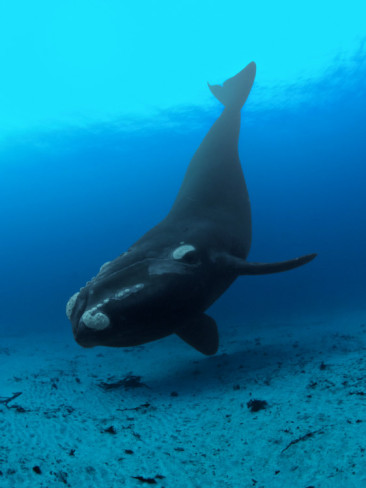Interactions
Southern Right Whales (Eubalaena australis) interspecies
interactions have been observed in brief infrequent instances. One
highly recorded interspecies interaction took place prior to 1925
between E. australis and humans. Prior to the great whaling
expedition there were estimated to be 10,000 E. australis In the New
Zealand area. E. australis is the most vulnerable of all baleen
whales. They are slow swimmers, and highly buoyant due to their
large quantities of oil. E. australis was known as the "right
whale" for hunting. These whales were easy to capture, floated after
being harpooned, and their baleen was valuable and manufactured into
a variety of commodities. Only the blue whale suffered a greater
decline in population (Hutching, 2012).
Eubalaena australis have been sighted on a number of occasions
traveling with humpback whales. The behavior of both whale groups
was described as resting, milling, and predominantly traveling. Both
groups sighted were traveling in a south. On another occasion E.
australis was sighted with Indo-Pacific
bottlenose dolphins (Schaeff
et al., 1999). This species identification was noticed due to the
disruption of color. It is speculated that E. australis join or even
follow humpback whales to and from the Mozambique breeding grounds
(Harrison, 2005). Evidence of this includes location of both
breeding grounds and presence of coronuline barnacles (found in
humpback whale mating sites) on E. australis (Best, 1991). The two
species have been seen traveling together in Antarctica. The
relationship between E. australis and South African humpback whale
is unlikely to be sexual (Sekiguchi et al., 2010).
Killer whales have been observed preying on Eubalaena australis.
Similarly to their vulnerability to humans, the E. australis are
vulnerable to vicious killer whale attacks. Although much larger,
the E. australis are much slower. E. australis are not common prey
for
killer whales, it is speculated that this prey may have been in
a time of need. Killer whales are not considered common predators of
the E. australis.
Eubalaena australis are identified in part by the callosities on
their heads. These callosities are grey and soft when the whales are
calves and harden as the whale matures (Hutching, 2010). These
callosities are often infested by lice. This whale lice is what
gives the callosities their white color (Harrison, 2005).
These baleen whales are sustained on plankton and krill obtained through skimming. Eubalaena australis swims with its head partial above water filtering mouthfuls of prey between baleen plates (Smith, 2000). When their mouth is full, the E. australis forces water out, dives and swallows.
Click here to continue onto our Facts page or go back to our Home page!

